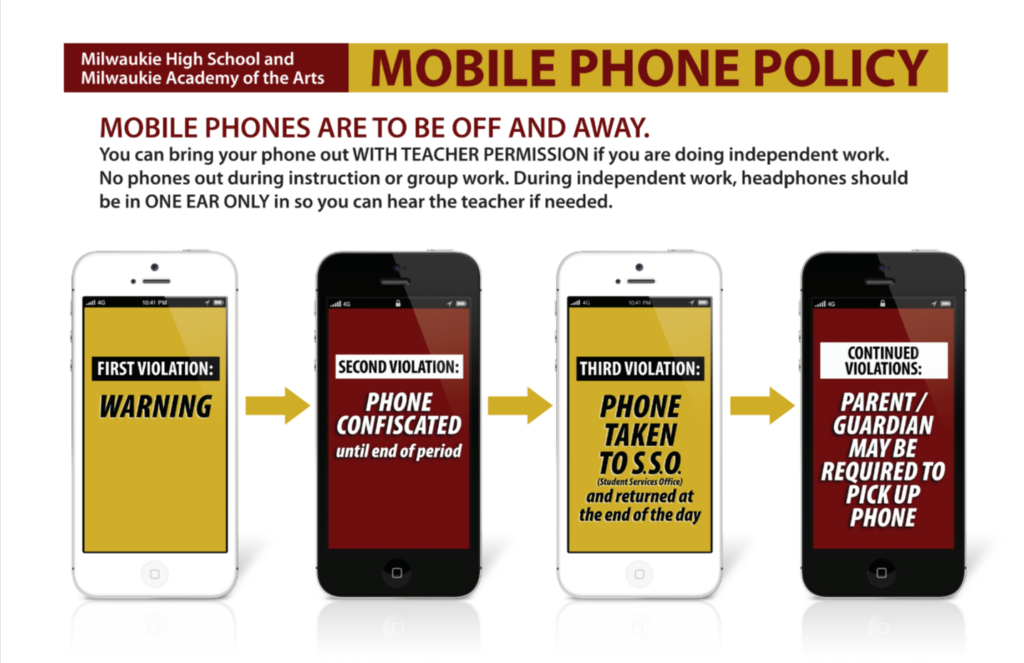Student Cell Phone Policy: Best Practices for Student Success

There’s increasing evidence that the presence and usage of cell phone in the classroom—while not necessarily detrimental in all contexts—should be carefully monitored, intentionally structured, and even restricted in some cases.
– Edutopia

INTRO
Even limiting the discussion of cell phone use to the context of school may seem to do little to whittle down the debate and concerns. We recognize that ultimately cell phone ownership and use is a decision for families and students. We also recognize that their evolution from luxury to necessity—and expectation—occurred before many students were even born. And we recognize that mobile devices can and do have their place as tools to enhance the learning experience. However, we also know that unregulated cell phone use in the school setting—and specifically the learning environment—can hinder, rather than enhance, learning.
As principal of Milwaukie High School, Carmen Gelman (now Director of Professional Development, Coalition of Oregon School Administrators, COSA) worked with the school community (including students) to ensure a firm but balanced approach to student cell phone use. We share their policy and rollout materials to inspire and guide you as you consider tackling this contentious topic.
OBJECTIVES
- Review and reflect on MHS Cell Phone Policy materials
- Consider your own school cell phone policy (or lack thereof)
- Brainstorm developing a cell phone policy that works for your school and how to get everyone onboard with its launch and implementation
ACTIVITY
- Read/watch the brief Edutopia article and video for some insights into why regulating cell phone use in the learning environment is important.
- Watch the 5-minute MHS Phone PSA video that was used to communicate the new policy
- Review the MHS Cell Phone Policy Poster that was shared and posted for consistent reminders

BEST PRACTICES TO CONSIDER
TIMING/TIME TO PROCESS
- Ideally, new policies coincide with the start of a new school year, but if you find yourself in need of making a change mid-year—as Carmen and MHS did—consider how you can time it to give everyone time to mentally adapt to the change.
- In the MHS example, they announced the change and communicated expectations before they went on a week-long spring break to give everyone time away from the school setting to process the change.
- Don’t forget communicating with families as well.
THE WHY
- Ensuring “the why” is clearly communicated is always a best practice for any policy, change, etc.—and not just for students!
- Notice that “the why” communicated in the PSA is student-positive not student-punitive (and directly connects with the next best practice below), but also utilizes concrete data to support the rationale for the policy (it’s not just “because we say so”).
WE/I CARE
- Notice there are a lot of “I” and “we” statements throughout the PSA video. And the “I/we care about you” is clearly and sincerely communicated. Carmen even says she feels like she’s failed her students as a principal by not intervening sooner.
- Accepting ownership and responsibility for our role shows students we aren’t placing all the blame on them, and that as the adults, it’s our responsibility to make tough decisions to ensure they are safe and supported and successful.
- Also, later in the PSA, it’s pointed out that adults also have a hard time putting their phones away and also need to be reminded to do so.
CLEAR EXPECTATIONS AND CONSEQUENCES
- The expectations of when cell phone use is absolutely acceptable and how to go about seeking an exception when needed are clearly communicated.
- The consequences of when the policy is violated are clearly communicated and the steps allow for forgetfulness, etc.
UNITED FRONT
- This is schoolwide policy that all students and adults are expected to follow.
- Again, it’s we‘re in this together.
TIPS
- Develop a tracking system and ensure accurate and consistent tracking of policy violations to be compared with other behavior and academic measures, so you’re able to quantify the effectiveness of the policy as well as any trends among individual and/or groups of students, timing of violations, etc.
- Be transparent with this data. If it’s effective, let the school community, so you can celebrate together. If it’s not working, let the school community know, so you can brainstorm what’s working and not working to improve it together.
- You may consider incentivizing following the policy (for students and staff) at least for a time after the initial launch, but the real incentive is students’ success, so be careful so as not to rely on extrinsic reinforcement for too long.
FOR ELEMENTARY
- While this example is for secondary, we recognize that cell phone use is also a problem in elementary schools. The best practices outlined above hold true for younger students, but the language and levels of expectations and consequences may need to be adjusted (perhaps a “practice” period of time before consequences go into effect). More family involvement/communication would also be advisable.






Responses